InfoCube Design Alternative I Time-Dependent Navigational Attributes
In the Part I InfoCube design, IO_SREG and IO_SOFF are in a hierarchy of IO_SREP as the hierarchy's node values (Screen 3.46). In this section, we will discuss an alternative by putting IO_SREG and IO_SOFF into a new IO_SREP, or IO_SREPN1, as time-dependent navigational attributes.
First, we show how to build this new design.
Work Instructions
Step 1. In the definition of IO_SREPN1, append IO_SOFF and IO_SREG after the existing IO_SREPNM as attributes.
Make IO_SOFF and IO_SREG time-dependent by selecting the corresponding rows in the column Time-Dependent. Click  to switch them from display attributes to navigational attributes.
to switch them from display attributes to navigational attributes.
SCREEN 7.12

Step 2. Enter the description Sales office for the navigational attribute IO_SOFF, and Sales region for IO_SREG.
(Screen 7.13 shows the description for IO_SOFF only.)
SCREEN 7.13
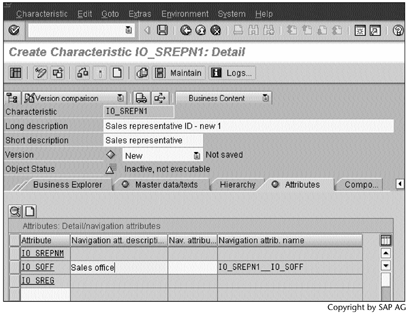
Step 3. Click  to check the InfoObject. If it is valid, click
to check the InfoObject. If it is valid, click  to activate the InfoObject. The time-dependent master data table /BIC/QIO_SREPN1 and the time-dependent SID table /BIC/YIO_SREPN1 are created. Their names appear in the Time-dependent master data tables block.
to activate the InfoObject. The time-dependent master data table /BIC/QIO_SREPN1 and the time-dependent SID table /BIC/YIO_SREPN1 are created. Their names appear in the Time-dependent master data tables block.
SCREEN 7.14

Step 4. Double-click the SID table /BIC/YIO_SREPN1 to reach its definition screen.
Here we see two time-related fields, DATETO and DATEFROM. When we load data, we use these two fields to specify a record's valid period. DATETO is part of the key that makes a record unique.
We also see two other SID fields, S__IO_SOFF and S__IO_SREG. BW uses them to link IO_SREPN1 to IO_SOFF and IO_SREG, moving IO_SOFF and IO_SREG one more level away from the fact table. This layout will negatively affect query and load performance.
SCREEN 7.15
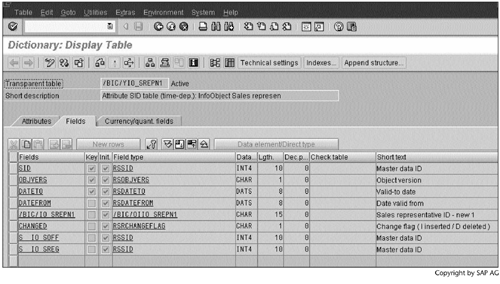
Step 5. Follow the work instructions in Section 2.5 to create a new InfoCube called IC_NEWBC1. In the InfoCube definition, click  to specify the navigational attributes.
to specify the navigational attributes.
SCREEN 7.16
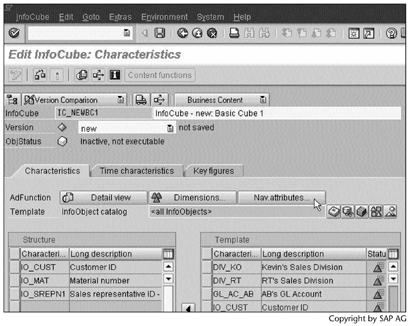
Step 6. In the pop-up window, check the I/O column to activate the two attributes, and then click  to continue.
to continue.
SCREEN 7.17
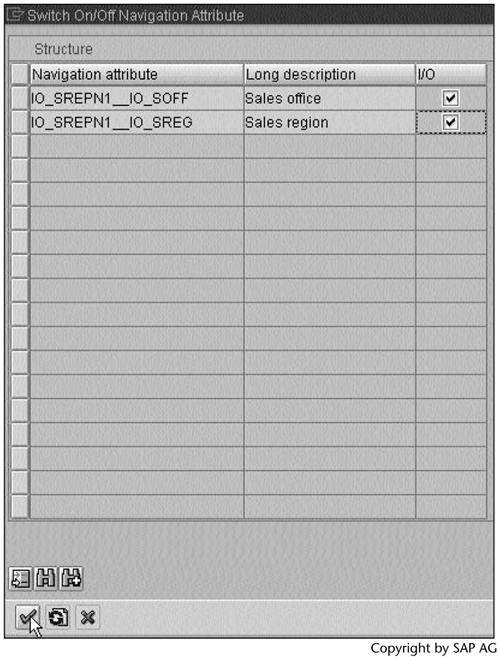
Step 7. After checking, activating, and loading data into the new InfoCube, we can create a query.
In the left panel, we see that Sales office (navigational attribute), Sales region (navigational attribute), and Sales representative (characteristic) all reside in the same dimension. From the query point of view, the navigational attributes are just like their characteristic, allowing for drill-down.
Click ![]() to specify a key date.
to specify a key date.
SCREEN 7.18

Step 8. Enter 31.12.9999 as the key date, and then click  to continue.
to continue.
SCREEN 7.19

Result
The query result shows that the Denver office is located in the West region (Screen 7.20).
SCREEN 7.20
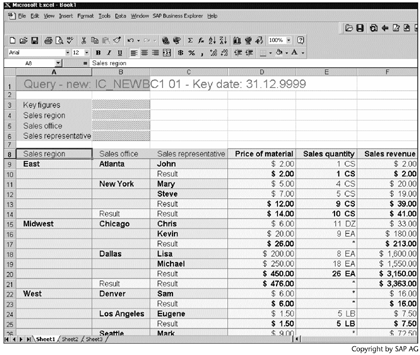
Create another query, but this time enter 31.12.1999, instead of 31.12.9999, as the key date (Screen 7.19). Screen 7.21 displays the result of the new query, which shows that the Denver office is now located in the Midwest region.
SCREEN 7.21
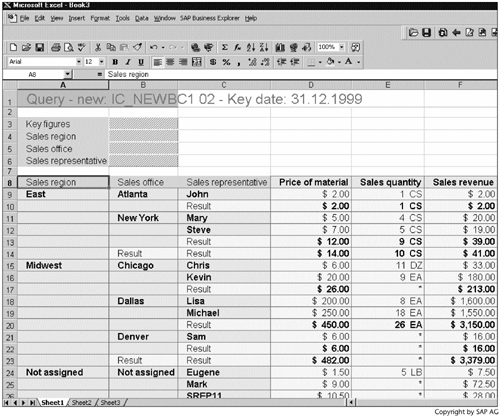
Note
Based on our discussion, we can draw a simplified star schema as shown in Figure 7.2 for this design alternative.
Figure 7.2. BW STAR SCHEMA OF ALTERNATIVE I INFOCUBE DESIGN
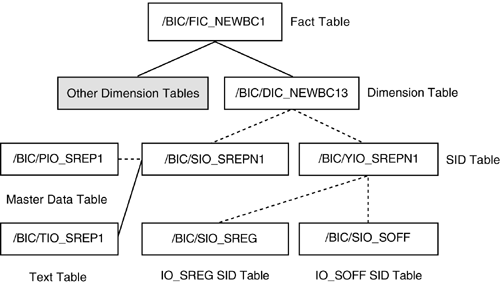
In Figure 7.2, /BIC/SIO_SREG and /BIC/SIO_SOFF have their own master data table and text table. These tables are not shown in the figure.
Because IO_SREG and IO_SOFF are placed one level farther away from the fact table, query performance will be poor with this design.
Because IO_SREG and IO_SOFF are hidden inside IO_SREPN1, we cannot build aggregates on IO_SREG and IO_SOFF.
Navigational attributes facilitate system maintenance. For example, if we need to reassign sales offices and sales regions, we can create new records in the master data table with corresponding valid dates.
This design, however, is not flexible enough to permit structure changes, because the levels of the sales organization are fixed.
Part I. Guided Tours
Business Scenario and SAP BW
- Business Scenario and SAP BW
- Sales Analysis A Business Scenario
- Basic Concept of Data Warehousing
- BW An SAP Data Warehousing Solution
- Summary
Creating an InfoCube
- Creating an InfoCube
- Creating an InfoArea
- Creating InfoObject Catalogs
- Creating InfoObjects Characteristics
- Creating InfoObjects Key Figures
- Creating an InfoCube
- Summary
Loading Data into the InfoCube
- Loading Data into the InfoCube
- Creating a Source System
- Creating an Application Component
- Creating an InfoSource for Characteristic Data
- Creating InfoPackages to Load Characteristic Data
- Checking Loaded Characteristic Data
- Entering the Master Data, Text, and Hierarchy Manually
- Creating an InfoSource for Transaction Data
- Creating Update Rules for the InfoCube
- Create an InfoPackage to Load Transaction Data
- Summary
Checking Data Quality
- Checking Data Quality
- Checking InfoCube Contents
- Using BW Monitor
- Using the Persistent Staging Area (PSA)
- Summary
Creating Queries and Workbooks
- Creating Queries and Workbooks
- Creating a Query Using BEx Analyzer
- Organizing Workbooks Using BEx Browser
- Using a Variable to Access a Hierarchy Node Directly
- Summary
Managing User Authorization
- Managing User Authorization
- Creating an Authorization Profile Using Profile Generator
- Creating an Authorization Object to Control User Access to the InfoCube Data
- Integrating Profile Generator and BEx Browser
- Summary
Part II. Advanced Topics
InfoCube Design
- InfoCube Design
- BW Star Schema
- InfoCube Design Alternative I Time-Dependent Navigational Attributes
- InfoCube Design Alternative II-Dimension Characteristics
- InfoCube Design Alternative III Time-Dependent Entire Hierarchies
- Other InfoCube Design Techniques
- Summary
Aggregates and Multi-Cubes
Operational Data Store (ODS)
- Operational Data Store (ODS)
- Creating an ODS Object
- Preparing to Load Data into the ODS Object, Then into an InfoCube
- Loading Data into the ODS Object
- Loading Data into the InfoCube
- Using 0RECORDMODE for Delta Load
- Summary
Business Content
- Business Content
- Creating an R/3 Source System
- Transferring R/3 Global Settings
- Replicating R/3 DataSources
- Installing Business Content Objects and Loading R/3 Data
- Summary
Generic R/3 Data Extraction
- Generic R/3 Data Extraction
- Creating Views in R/3
- Creating DataSources in R/3 and Replicating Them to BW
- Creating a Characteristic in BW
- Loading Data from R/3 into BW
- Summary
Data Maintenance
Performance Tuning
- Performance Tuning
- BW Statistics
- System Administration Assistant
- Tuning Query Performance
- Tuning Load Performance
- Summary
Object Transport
Appendix A. BW Implementation Methodology
Object Transport
Appendix B. SAP Basis Overview
Object Transport
- Object Transport
- Section B.1. SAP Basis 3-Tier Architecture
- Section B.2. Dispatcher, Work Processes, and Services
- Section B.3. Memory Management
Appendix C. Glossary
Appendix D. Bibliography
EAN: N/A
Pages: 106
